Communicable diseases, disease prevention & The Immune System: General Exam Questions
1/87
There's no tags or description
Looks like no tags are added yet.
Name | Mastery | Learn | Test | Matching | Spaced |
|---|
No study sessions yet.
88 Terms
A fly is a vector for a fungus. Why is fungus now widespread? (2)
-The vector is mobile
-Lack of resistance and diversity between trees
What kind of pathogen carries malaria?
Vector.
What is the pathogen that causes malaria and what kingdom does it belong to?(2)
-Plasmodium
-Protoctista
Suggest two ways to minimise the spread of an outbreak of plague.
-Staying indoors
-Ensuring measures to kill the protists
-Quarantining
When investigating resistance, why is it important to use clones of a plant?
-There's no genetic variation
-So increases validity as there are more control variables
What does aseptic mean?
sterile/without contamination
What is tissue culturing?
Growing entire plant from individual cells or from small pieces of leaf, stem, or root
Why is asepsis important?
reduces contamination
What are factors affection direct pathogen transmission for humans?(4)
-Dense population
-Few trained healthcare workers
-insufficient health education
-Climate change
How does a dense population affect pathogen transmission?
higher contact rates, faster outbreaks, airborne spread, environmental contamination, and virulent strain selection
How does a lack of trained healthcare workers affect pathogen transmission?(2)
-lack of, vaccination / treatment
-lack of understanding of the way in which pathogen is, spread
How does insufficient health education affect pathogen transmission?
-Poor hygiene practices
-Misconceptions about disease transmission
-Hesitancy to take the vaccine
-Misuse of antibiotics
How does climate change affect pathogen transmission?
-Increased water-borne diseases
-Increased airborne disease transmission
-longer transmission seasons
How do we prevent a lack of healthcare workers as a factor?
-Send more professionals to the area
-More access to hospitals
-Have clinics train healthcare workers
What are spores?
reproductive cells that form without fertilization
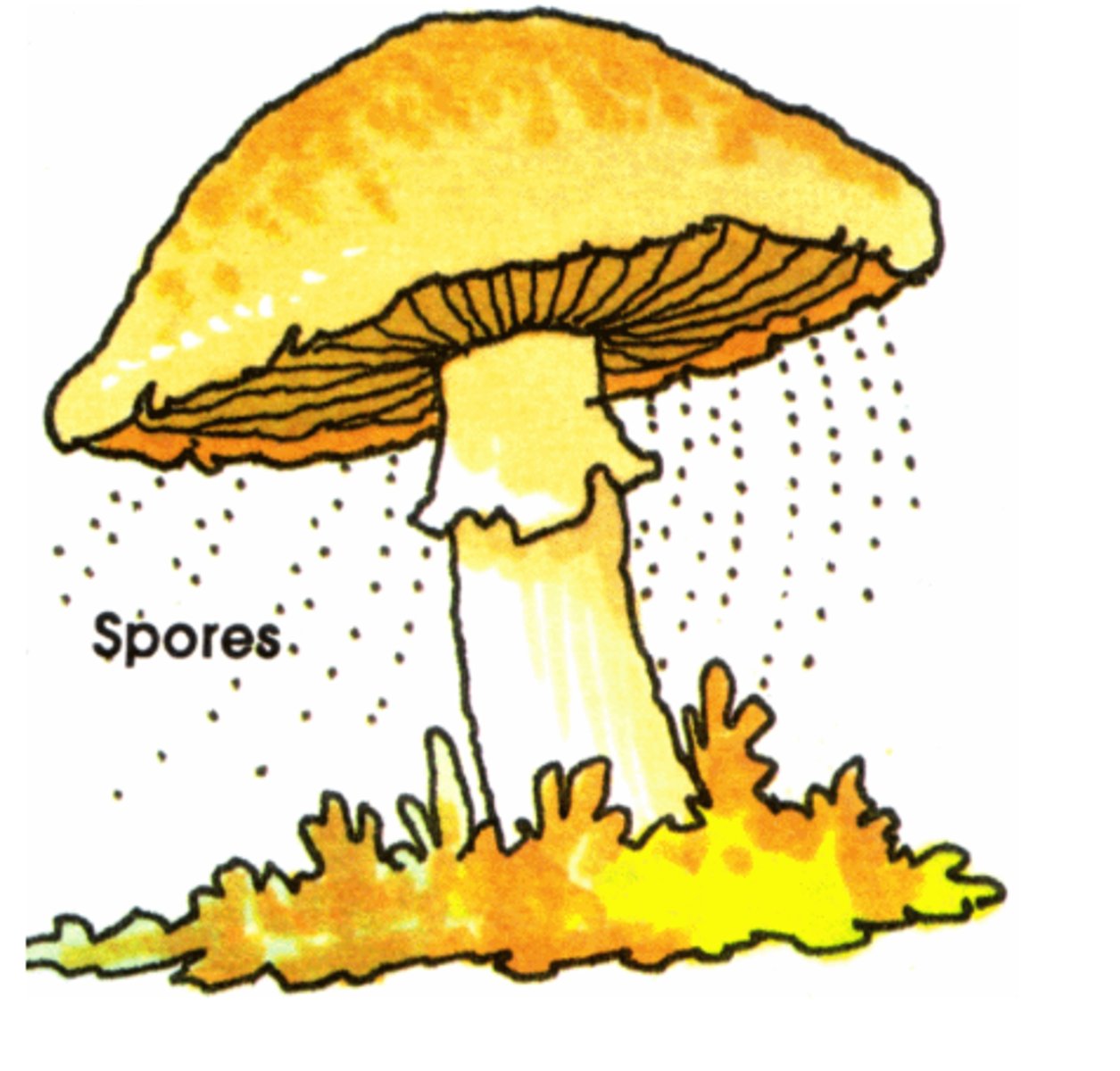
What is potato blight caused by?
A fungus-like protocist.
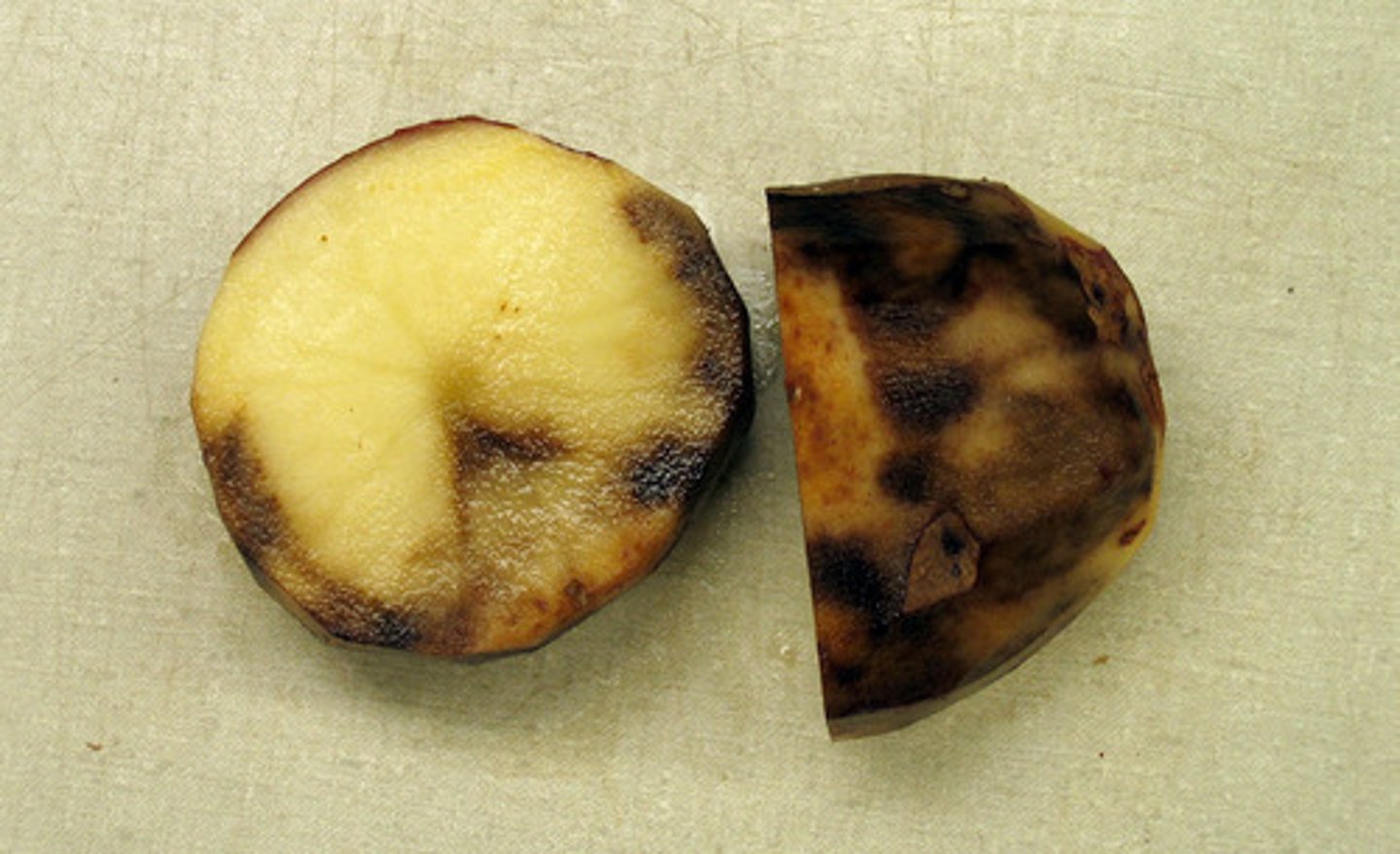
If dogs were to sniff a group of kids for malaria, what may the limitations be?
-Difficulty in interpreting the response of the dog
-Socks may have had washing powder used upon
-Sample size small
What is ring rot caused by?
bacteria
If making a practical for the observation of callose production under temperature, what would be the general observations needed to improve validity?
-THESE CAN BE USED FOR MOST EXPERIMENTS WITH PLANTS IN REGARDS TO TEMPERATURE, THINK ABOUT THE OSMOSIS PRACTICAL FOR EXAMPLE!!!!
-Use a range of temperatures with 10 degree intervals, from
0-40
-Repeat
If making a practical for the observation of callose production under temperature, what would be the control variable?
-Control = kept constant/same
-Same species of plant
-Same pH and nutrients to each plant
If making a practical for the observation of callose production under temperature, what would be the general observations needed to observe the callose?
-Use a microscope
-Use a stain to observe
-Take tissue samples
What are aromatic compounds?
antibacterial substances
What is abscission?
Leaf loss
If a plant were to have a disease that gave one of its leaves a brown discolouration, what could it do to prevent it from spreading to other parts of the plant?(3)
-Callose deposition
-Abscission
-Production of chemicals that prevent spread
What is the structure of cilia?
9 + 2 arrangement of microtubules
What is the function of ciliated epithelium?
-Moves in a rhythmic manner
-to move mucus
-Goblet cells secrete this mucus
-Which traps microorganisms
What is the importance of the cytoskeleton in regards to carrying out cilia movement?
-The cytoskeleton controls movement of organelles
-Also composed of microtubules that make up the cilia
How do mosquitos bypass the body's primary defences?
-The mouthparts of the mosquito pierce the skin
-And then injects the pathogen directly into the blood
What is the difference between neutrophils and lymphocytes?
-Neutrophils have a lobed nucleus
What is the structure of an antibody?
Y shaped molecule, four polypeptide chains: two heavy identical chains and two light identical chains held together by a disulfide bond, four constant regions (C), and four variable regions (V)
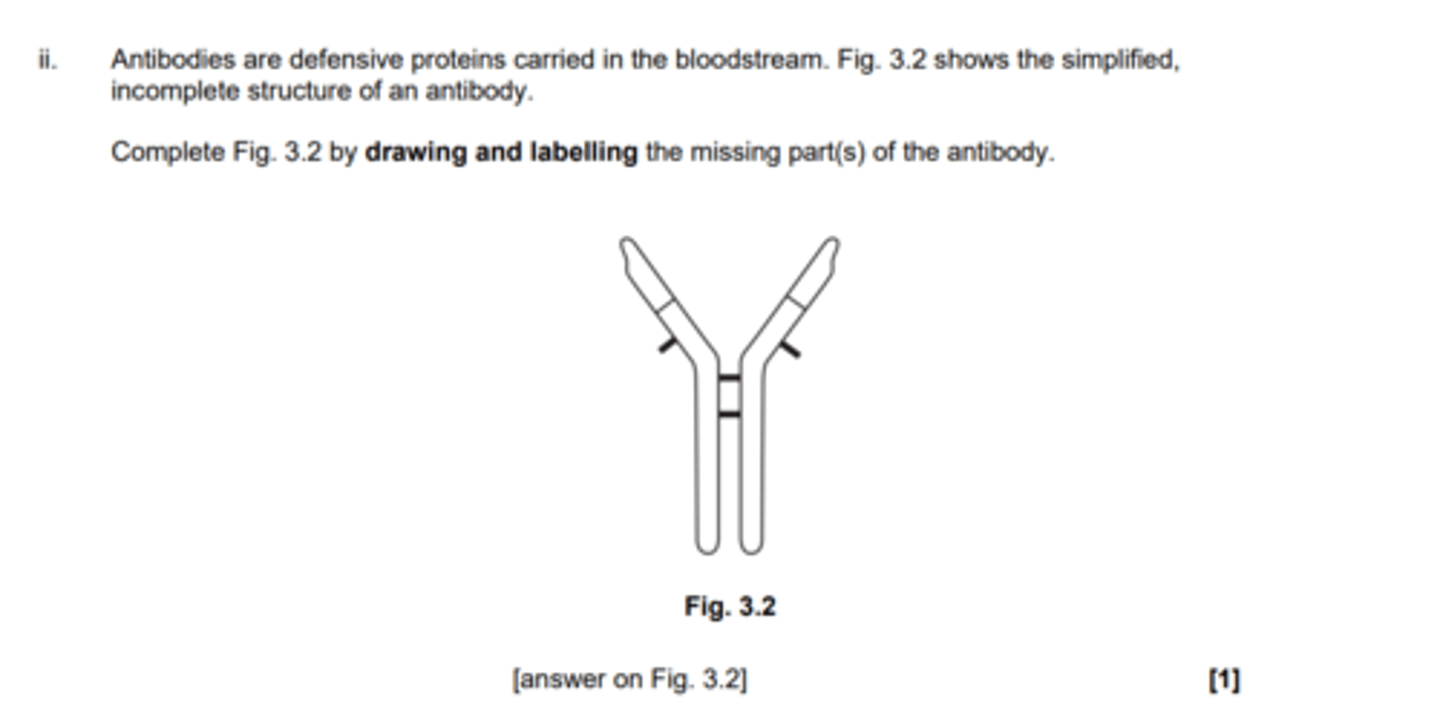
What type of cells have specific receptors complementary to an antigen?
B Lymphocytes
What happens to B Lymphocytes when an antigen binds to them?
They divide by Mitosis into plasma cells.
What do plasma cells secrete?
Antibodies complementary to the antigen.
What are B Lymphocytes?
A type of white blood cell that produces antibodies.
What are T lymphocytes?
cell-mediated immunity
What is the role of helper T cells?
stimulate B cells to divide via mitosis
What causes different strains of bacteria to be described as 'immunologically distinct'?
Different sequencing in amino acids
How do toxins relate to the immune response in bacteria?
Toxins act as antigens, and the immune responses depend on the shape of the antigens
What is cell mediated immunity simplified?
APC --> T Cells --> Interleukins released --> B Cells --> Clonal expansion/selection --> Plasma Cells --> Antibodies
How does cell mediated immunity occur?
-Macrophages engulf the pathogen and display the antigens on the cell surface, becoming antigen presenting cells(APCS)
-Helper T Cells then bind to the antigens presented by the APCs, releasing interleukins
-The interleukins then activate B Cells, so clonal expansion/ selection occur
-The B Cells then differentiate into Plasma cells
-These Plasma cells then produce antibodies
-These antibodies bind to and neutralise toxins.
If a virus has 4 antigens and you are exposed to the virus now and then 2 years later, and there's an equal response in all from the first exposure, but upon the second, some antigens have had less of a response, what may have happened?
-Some antigens may have mutated.
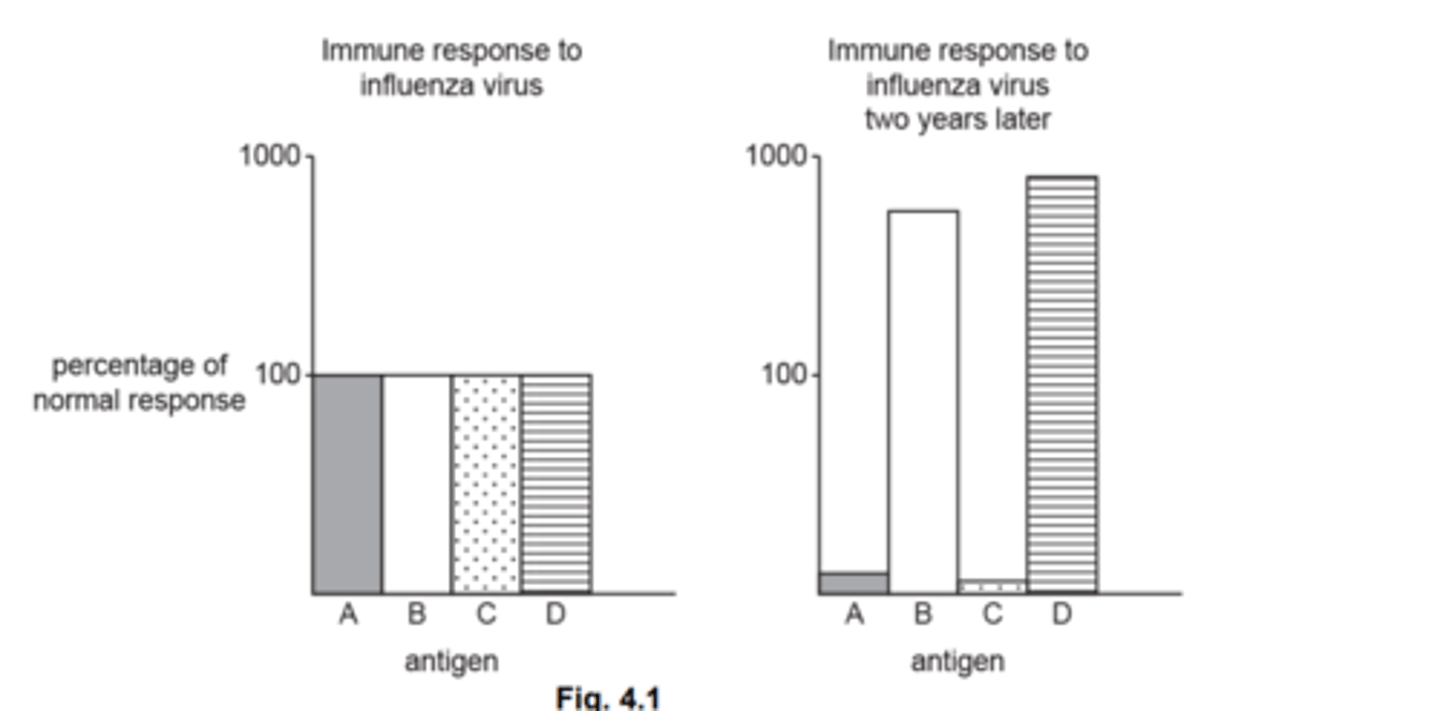
What is featured during the primary immune response?
delayed response
- clonal expansion/selection
-production of antibodies
What is featured during the secondary immune response?
- memory cells acting fast
- quicker response
- more antibodies produced
What is the hinge region of an antibody?
Allows flexibility when the antibody binds to the antigen
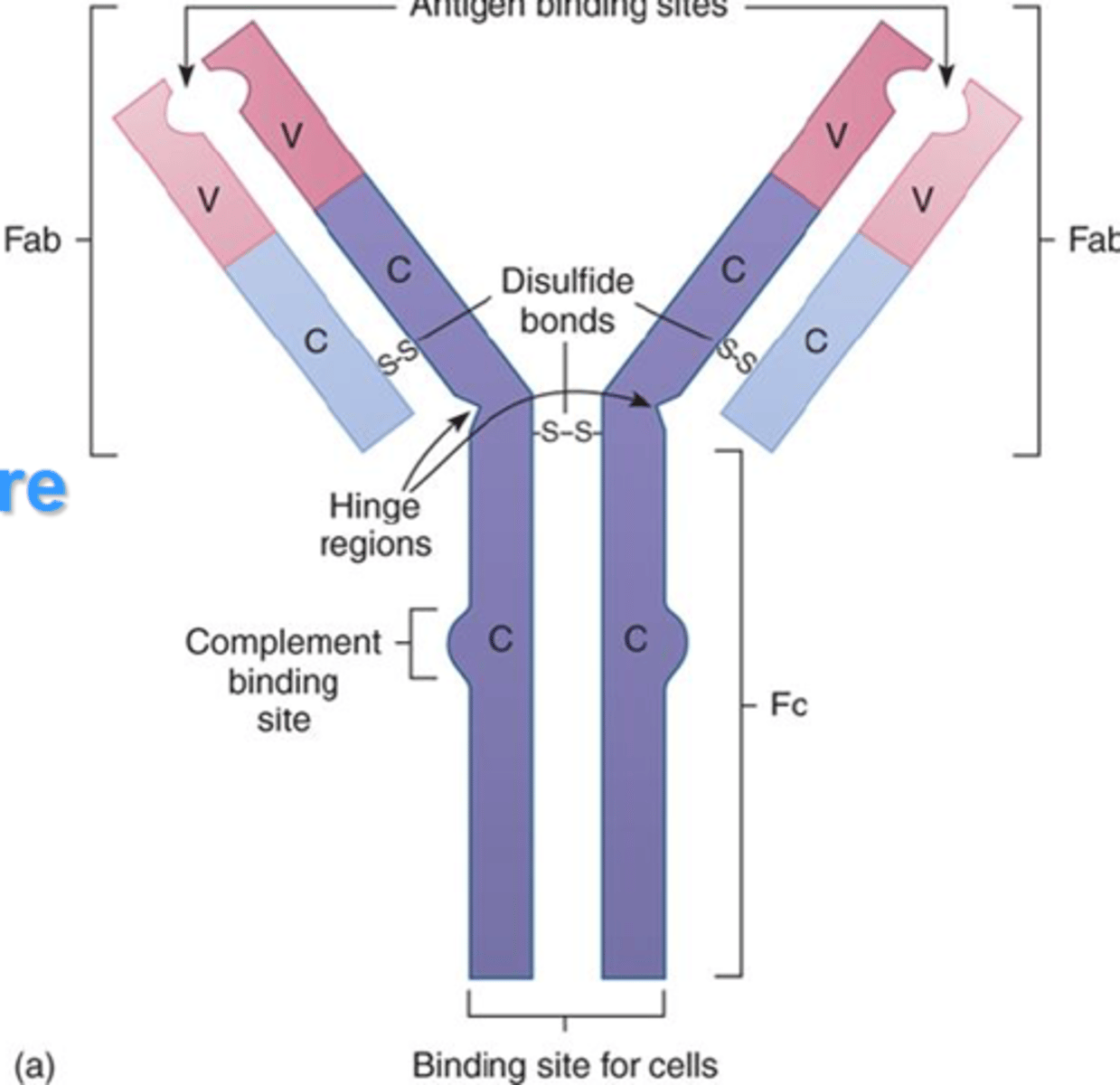
Suggest why antibodies specific to nuclear proteins are not normally made.
nuclear proteins are not normally exposed to the immune system
What do agglutinins do?
clump pathogens together so that phagocytes can engulf more at once
What is artificial immunity?
(patient) is not producing , antibodies / memory cells / immune response
Why are vaccinations examples of active immunity?
cause the body to generate its own immune response and memory cells, they are classified as active immunity
What is an autoimmune disease?
A disease in which the body's immune system attacks healthy cells.
How does a vaccine give an individual immunity?(8)
-A vaccine is produced that is in the safe form of an antigen
-A small amount of vaccine is injected into the blood of an individual to be vaccinated
-The pathogen then is engulfed and becomes an antigen presenting cell
-It then binds to the Helper T Cell to produce interleukins
-Activates B Cell Clonal Expansion and selection
-They then differentiate into plasma cells and produce antibodies
-Primary immune response
- Secondary immune response faster due to memory cells
Measles is a highly contagious viral infection. In October 2018, an outbreak of the disease on the island of Madagascar resulted in more than 50 000 cases of measles. Fewer than 50% of the population was vaccinated when the outbreak began. The government of Madagascar hoped to bring the epidemic under control by vaccinating 90% of the population. Discuss why this response was likely to bring the measles outbreak on Madagascar under control.
-Promotes herd immunity
-so fewer people can spread the virus
Why is it not possible for one vaccine to contain different pathogens?
-They all have different antigens
-Which all have specific shapes
- In which different antibodies would need to be produced for each pathogen
What are natural substances medicines come from?
-plants
-microorganisms
What happens when antibodies are overused?(4)
-Some bacteria has resistance, in which some bacteria are more resistant than others
-When exposed more that are resistant survive
-Those bacteria end up reproducing to make a resistant population(natural selection)
-so a new antibiotic is needed.
Why could bacteria become more resistant to an antibody?
-Overuse of antibiotic
-not completing course of antibody
-natural selection overtime
What can you conclude about this data?
-Outline a clear trend from a specific timeframe(with context to the graph)
- trend has been decreasing since 2007
-large decrease in deaths since 2007
Why could antibody resistance be fatal?
-harder to treat
-higher potential for a pandemic, which could kill many people
-producing new antibodies expensive
Why would antibodies be given to animals for domestic purposes?
-To prevent disease
-Have good gut health
-Reduce risk of transmitting to humans
What is a parasite?
an organism that lives on or in a host and feeds in it, at its expense.
How does the structure of antibodies link to their function?
-4 Polypeptide chains
-2 light, 2 heavy
-Variable region allowing for the binding to the specific antigen
-2 variable regions for the binding of more than 1 antigen
- Different for every antibody for binding to a variety of antigens
-Constant region allowing for attachment and binding to phagocytes
-Hinge region for flexibility
-disulfide bridges holding light and heavy chains together
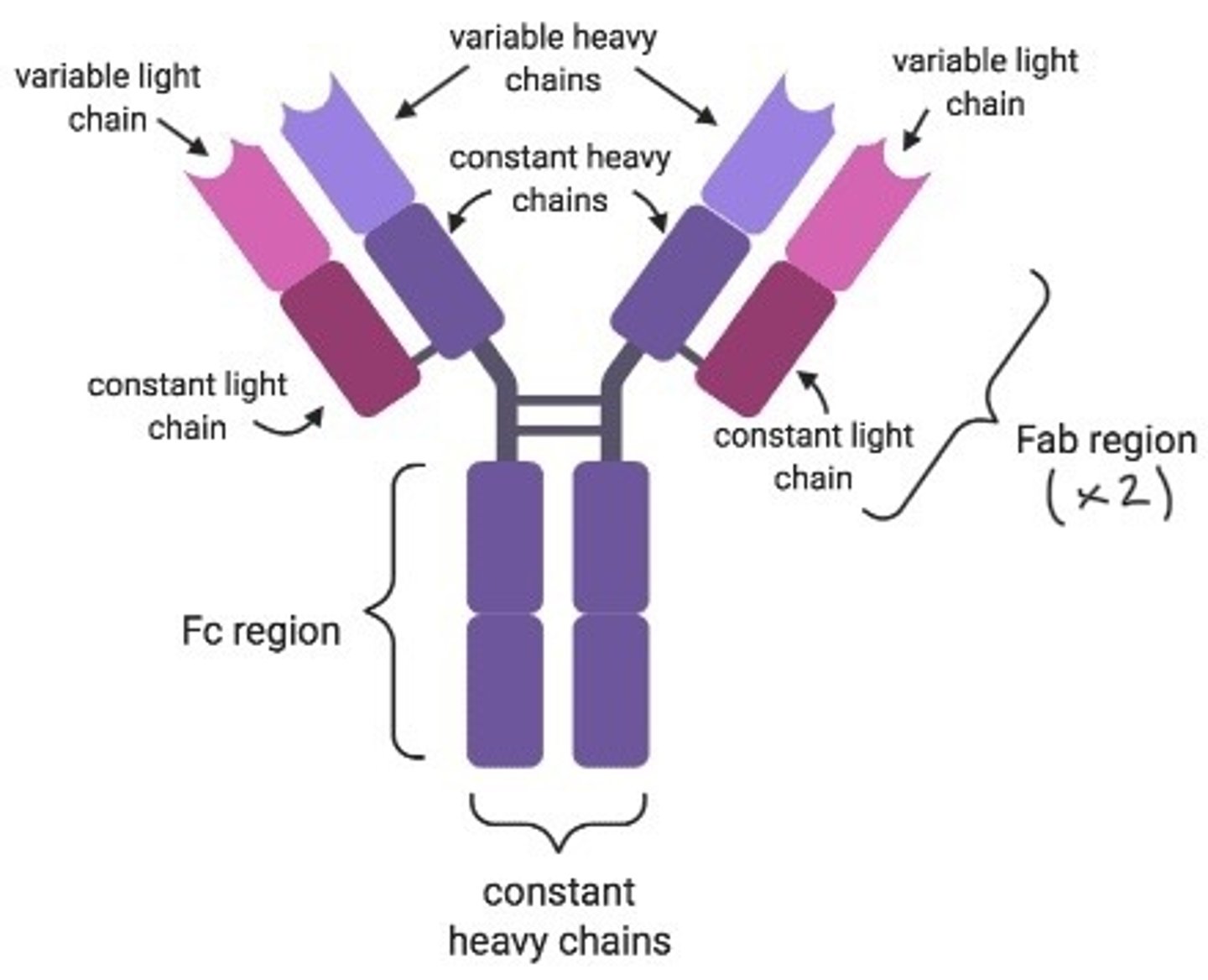
What is neutralisation?
-block pathogens
-by binding to the toxins
-to keep pathogens away from the host cell
What is agglutination?
-clumping of many pathogens
-prevents entry through the cell membrane
-so more are consumed by pathogens at once
What is the nucleus shape of a macrophage?
-Kidney shaped nucleus
What is the nucleus shape of a neutrophil?
-Multi-lobed nucleus
What are neutrophils and macrophages examples of?
-Phagocytes.
What is the definition of the secondary defence against pathogens?
-The defence involved after pathogen has entered the body
What is the process of phagocytosis after the pathogen is attached to the phagocyte?
-Pathogen engulfed
-via phagocytosis
-in which a phagosome is then formed
-lysosomes then move towards the phagosome and fuse with it
-enzymes called lysozymes digest the pathogen via hydrolysis
-turning the pathogen into amino acids
-products are then absorbed by the cytoplasm
-and unwanted products are removed via exocytosis
How is tuberculosis passed from one to another?
-droplets
-released by coughing
- which travel to another individual
Why is it that poorer people are usually the statistic with the most cases of a disease?
-Overcrowded living space
-Poor diet
-Homelessness
-Poor health
Healthcare less difficult to access
Why isn't hygiene a main factor in regards to air-borne diseases?
-Air borne, so spreads through droplets, so having good hygiene still won't prevent the disease from spreading
What are differences between eukaryotic cells and prokaryotic cells?(5)
-No cell wall
-Linear chromosomes
-DNA has histones
-Presence of nucleus
-Membrane-bound organelles
How does the mosquito carrying Plasmodium transmit it to a human?
-Mosquito acts as a vector for the parasite
-Plasmodium migrates to the salivary glands
-and bites the human, in which the Plasmodium is passed from the salivary glands into the blood
What substance can T lymphocytes produce to destroy pathogens?
-Perforin
What is the function of perforin?
Forms a hole in the cell membrane, allowing granzymes to enter
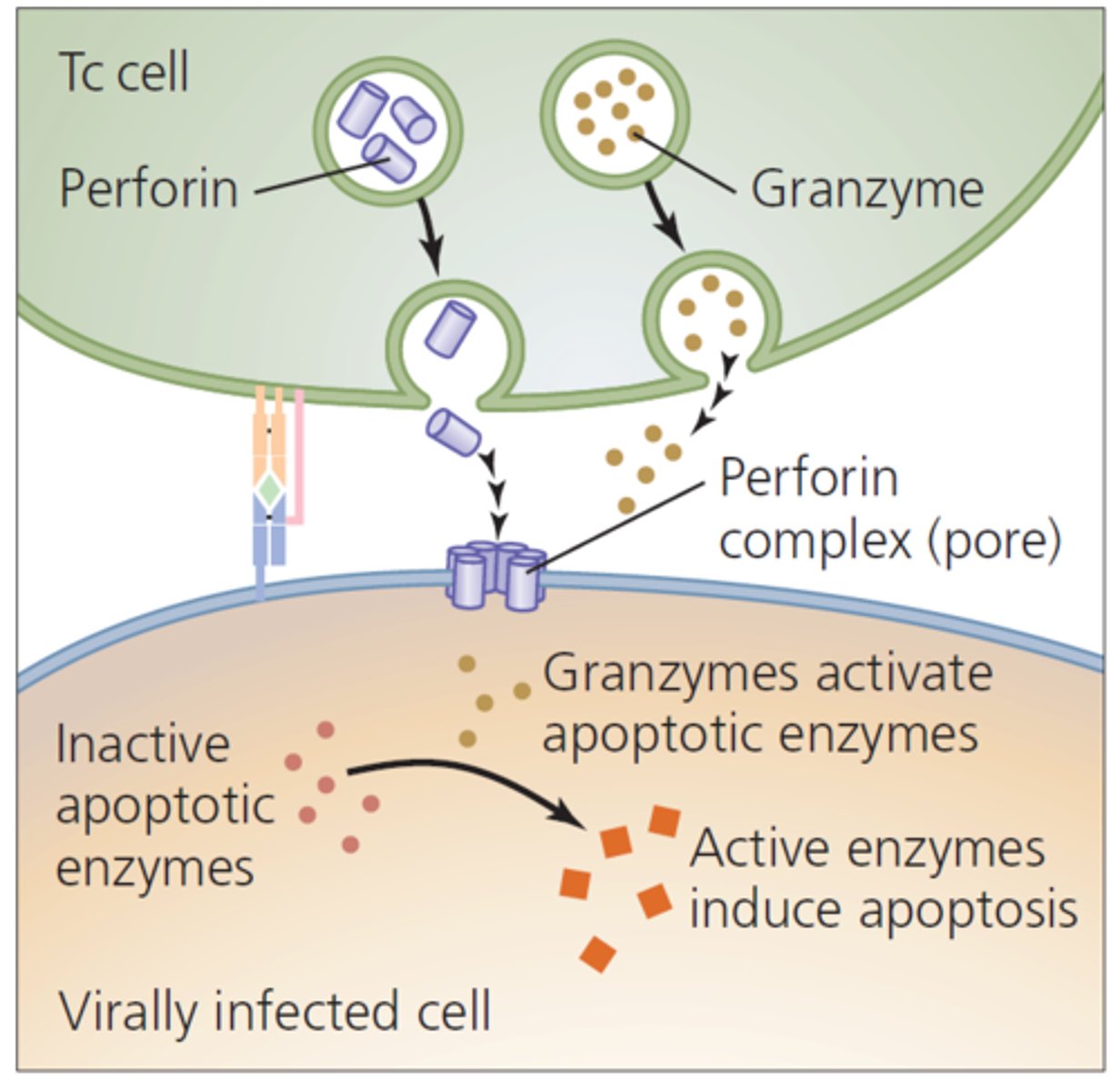
What cells produce perforin?
T killer cells
What is the function of a memory cell?
-recognises the pathogen
-and divides by mitosis to form many plasma cells
-which make antibodies
- and is mainly involved in the secondary immune response
What is the function of a virus?
Entering a host cell and reproducing, and bursting the cell, to spread to more
Why would researchers use plants to combat disease?
-Fewer side effects
-Reduces time in finding active chemicals
-More cost effective
What is the monomer of nucleic acids?
nucleotides (sugar, phosphate, nitrogen containing base)
What are an example of cytokines?
Interleukins
How do interleukins stimulate the dividing of B cells?
-Has a specific shape
- Then binds to the receptor on the cell surface membrane of the B Lymphocyte
-as they have complementary shapes
-Which stimulates clonal expansion.

What is health?
-free from disease
- And a good state of physical and mental wellbeing
Outline the humoral response.
-B Cells have receptors which are complementary to one antigen
-When the antigen attaches to the receptor, it triggers clonal selection
-which is the selection of the appropriate B cells
-which is stimulated by T helper cells
-And then Clonal Expansion undergoes
-In which the selected cell divides by mitosis and differentiate to form Plasma Cells
-Which then secrete antibodies which have complementary receptors to antibodies
-And then memory cells are produced.
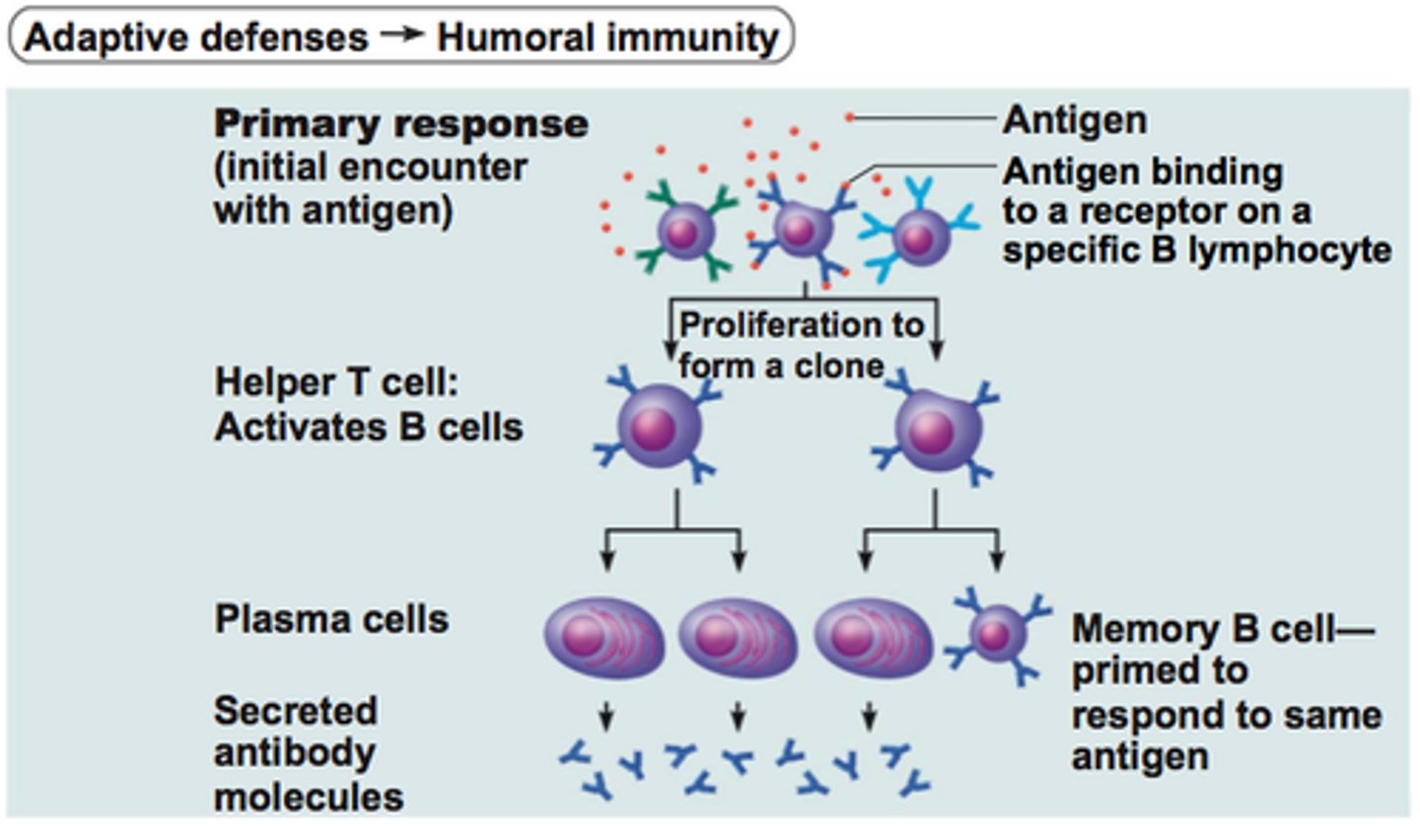
Suggest why adults who have survived malaria may lose their immunity when they leave a malarial area.
-Lack of exposure
-Loss of memory cells overtime
State three biological reasons why it has not been possible to produce an effective vaccine for malaria.
-Different strains due to mutation
-Parasite hidden in cells and only have short exposure
-Different strains require different vaccines
The use of antibiotics as growth promoters in animal production was banned in the European Union in 2006. Suggest a concern that led to this ban.
-Antibiotics may lead to antibiotic resistance
-And also kill off useful bacteria